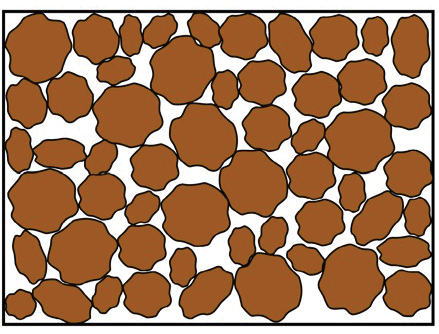Soil Compaction in Mississippi Landscapes
Soil compaction leads to many of the problems faced around new home sites and in existing landscapes in Mississippi. Soil compaction is often caused by heavy construction equipment and constant traffic at a construction site or on wet soils. Compacted soils provide a stable foundation for buildings, but they are not ideal for plant growth or water movement. In many cases, it may be nearly impossible to establish plants in compacted soils. Soil compaction reduces the total number and size of air-filled pores, which are critical in supplying plant roots with oxygen (Figure 1). Compaction increases soil resistance to penetration, making it difficult for roots to grow through the soil. This can cause poor or shallow rooting, which can lead to poor plant growth and an increased need for irrigation and fertilization. If soil compaction leads to dead or declining plants, landscape professionals and homeowners face a steep cost to replace these plants.


Figure 1. Illustration of compacted (top) and uncompacted (bottom) soils.
The level of soil compaction can be determined by measuring soil bulk density, or the mass of dry soil per unit volume (for example, grams per cubic centimeter or pounds per cubic foot). Soil bulk density accounts for the spaces between the soil particles (pore space), as well as the soil solids.
Soils with a high proportion of pore space have low bulk densities; soils with a low proportion of pore space have high bulk densities. Bulk density may range from normal (approximately 1.4 g/cm-3, 87.4 lb/ft3) to extremely packed (2.2 g/cm-3, 137 lb/ft3) in urban soils.
A quick soil compaction test that is simple to per- form—but less accurate—requires only a pencil or small knife. When the soil is at field capacity (wet, but not completely saturated), try to press the pencil into the ground using only your thumb and index finger. If it goes in easily, there is no major soil compaction. Repeat this process in several random locations across the area of suspected compaction to make sure. If it is hard to push the pencil into the ground up to 6 inches, you may have a soil compaction issue.
Dealing with Soil Compaction
Prevention
The easiest way to deal with soil compaction in land- scapes is to prevent it from happening. You can do this by eliminating or reducing the amount of traffic over the future planting areas during site construction or when soils are wet. Spreading a thick layer of mulch over the planting areas may also reduce soil compaction. However, when you walk up to a new landscape job site, it is probably safe to assume that the soil is already compacted. In that case, there are a few options for improving compacted soils.
Tilling and Cultivation
Tilling and cultivation can be used to break up the soil compaction and create more pore space, allowing water to infiltrate and roots to grow. There are several different approaches to tilling.
- Deep tillage can be used to break up compaction (up to 24–36 inches deep) in the subsoil. It requires large machinery and is often impractical because of buried utilities and the cost associated with it. It cannot be used to improve existing landscapes.
- Shallow tillage with a rototiller or similar equipment is one of the most effective ways of breaking up surface compaction. However, it can only improve conditions in the top 6 inches of soil. Shallow tillage is usually done at a depth that will not damage buried utilities, but it should never be done around existing trees and cannot be used in existing turf.
- Plug aeration is frequently used to reduce compaction in large turf areas, like golf courses and athletic fields. It is not as effective as shallow tillage, but it offers a safe alternative in existing landscapes.
- Air tilling/air spading is as effective as shallow tillage and is safe around trees because it will not damage the root systems. It uses compressed air from a special high-pressure gun to loosen the soil. This technology was developed by the gas industry to safely excavate around buried gas lines and is gaining popularity among arborists worldwide. This method cannot be used in existing turf.
Organic Amendments
Adding organic amendments to soil helps reduce soil compaction and increase the soil’s water- and nutrient-holding capacity. Organic amendments can be incorporated into the soil using tillage in new landscapes. There are many organic amendments that can be used to relieve soil compaction (compost, peat, pine bark, manures, recycled yard wastes, and municipal biosolids). When selecting an organic amendment, make sure it is well composted. If it is not completely composted, it can compete with the plant material for nutrients as it decomposes. When well mixed, a 1- to 2-inch layer of the organic amendment is usually enough to improve the top 6 inches of soil.
Organic amendments can also be applied as a topdress (material spread across the top) in both existing and new landscapes. Topdressing organic amendments is not as effective in alleviating soil compaction as incorporating them with tillage, and the results are slower to appear. When topdressing existing landscapes with compost, you should add no more than one inch at a time so that plant material is not covered up or smothered. Mulch can also act as a source of topdressed organic matter as it decomposes. You should never incorporate uncomposted mulch into the soil. The effect of mulch on soil organic matter will depend greatly on its decomposition rate.
Soil Replacement
The most intensive and expensive method of dealing with soil compaction is soil replacement. This involves excavating the compacted soil on the site and replacing it with another material. This may simply be a different fill soil, or it can be an “engineered soil.” Engineered soils (sometimes referred to as structural soils) are specifically designed to provide the soil strength required to support a structure (usually created by compaction), as well as meet the plant requirements for healthy root growth and development. There are several commercially available engineered soils for use in urban landscapes.
Sand should never be added to a soil with a high clay content to alleviate soil compaction. The resulting mix is usually much worse than the clay alone. The clay acts like cement, and when it is mixed with the sand, it becomes similar to concrete. Again, never mix sand into a clay soil to deal with soil compaction.
Reference
Shober, A., and G. Denny. 2012. Soil Compaction in the Urban Landscape. UF-IFAS Extension Publication SL 317.
Publication 3748 (POD-03-22)
Reviewed by Larry Oldham, PhD, Extension Professor, Soils, and Keri Jones, PhD, Laboratory Coordinator, MSU Extension Soil Testing Laboratory, from the original by Geoffrey C. Denny, PhD, former Assistant Extension Professor, and Keith Crouse, PhD, Associate Extension Professor (retired).
The Mississippi State University Extension Service is working to ensure all web content is accessible to all users. If you need assistance accessing any of our content, please email the webteam or call 662-325-2262.







